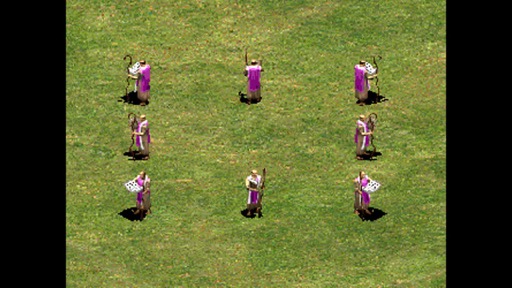22 - Wololo
Become a Patron!

All sound effects in this episode come from Age of Empires or Age of Empires II, except when otherwise noted. Music is a mix of my own stuff and a few tracks from the Age of Empires soundtrack, plus snippets from Babes Wodomu's Wololo, R.E.M.'s Losing My Religion, Microsoft's Age of Empires: Definitive Edition launch date trailer, and a random fan-made wololo song I found.

Thanks as always to my supporters on Patreon — especially my $10+ backers Vivek Mohan, Simon Moss, Wade Tregaskis, Eric Zocher, and Seth Robinson. If you'd like to become a supporter, for as little as $1 a month, head to my Patreon page and sign up.
I've also just added a third way that you can donate to the show — a premium, ad-free feed on Breaker, where you'll get all the bonus audio that goes to Patreon (but none of the non-audio Patreon perks) for a monthly subscription of US$2.99. Head to https://www.breaker.audio/the-life-and-times-of-video-games-premium for more info.

The Age of Empires II monks get to convert units, too — though their sound effect isn't as cool
(Partial) Transcript
[Play sound effect]
You'll probably recognise those sounds if you've ever played the hit strategy game Age of Empires — and maybe even if you haven't. It's what the priest units say while they attempt to convert an enemy unit to their religion, through the magic of a repetitive chant.
It was a way to turn the tides of battle without firing a single shot, a means of distraction — to turn an enemy's forces upon themselves — or of destruction. You'd give the convert command and moments later, provided your priest had enough energy, the target unit would suddenly swap to your colours — a red-uniformed guy turned blue, or whatever colour your army wore. Then you could marvel as chaos ensues.
The wololo, as fans called it, in a nod to the priest's chant, became one of Age of Empires' most iconic moments, immortalised not only in player stories — of which there are thousands floating around online — but in meme.
So how did some silly little nonsense chant from an old computer game come to be a viral cultural phenomenon, with a life of its own far beyond the game?
***
The story starts in 1994 at an IT consulting company called Ensemble Corporation. One day Ensemble co-founder Tony Goodman and programmer Angelo Laudon decided they wanted to have the company do a side project, with just a small team, where they make a game. So they and a group of Ensemble employees, plus Bruce Shelley — the co-creator of Sid Meier's Civilization — went and started prototyping ideas.
They tried lots of different things before they settled on an idea to do something like Civilization, but in real-time, in a nod to Warcraft, a popular real-time strategy game that had just come out. And so they began building something they called The Dawn of Man — where you'd control a tribe of cavemen as they form a village and struggle for survival.
Chris Rippy: it's funny because it was really just a bunch of people whose — this was their first time to try and make a game and we were small, so everybody did tons and tons of different stuff.
This is Chris Rippy, sound designer and, when he was needed, also level designer on The Age of Empires, as the game would eventually become known. He'd gotten involved through his older brother David, who had been working with Ensemble on some database consulting stuff. David and Chris and their other brother Stephen were given joint responsibility over the game's audio: Chris would handle the sound effects while David and Stephen did the music. Here's Stephen:
Stephen Rippy: I remember we had this meeting where Tony sat us down and he said 'Well here's the game where we want to make. And I really want every piece of music to kind of tell a story. So you should be able to pull the music out of the game and get some kind of a story out of it even if you don't know what's going on in the game.' So we came up with all of these different scenarios — like the one that we decided to go with was a hunt. So the idea being these early cave people going out and hunting and bringing it back in. And try to tell that through the music.
The pair went out into the woods with some microphones and made a bunch of caveman hunting noises, then incorporated that into a rhythmic music piece.
Stephen Rippy: And then the end of the day we got it pretty close — you could tell what was going on and you could tell we're making tools, we're stalking the lion, killing a lion, bringing it back home.
And we put it in the game and it was a complete disaster. It was just a joke. *laughs*
They realised they'd overthought the whole thing. So they ripped it out and started again with a much more subdued, understated style that blended heavy percussion with a non-descript "wash" of synthesiser sounds — so chosen because they'd sound okay even on computers with crappy built-in MIDI sound cards.
Chris was also given helpful high-level direction from Tony Goodman for his sound design.
Chris Rippy: Tony was the president of the studio, but he was able to paint a pretty good picture of what the goals should be for sound on it. And that's one of the things I remember most — was him saying what he would like from it is to be able to turn off the monitor, not play the game, and almost have like a — not a meditation CD, but kind of an environmental CD playing. And what he meant by that is just make the game feel really alive and really peaceful when there's not combat going on, almost like a living world.
So I took that to heart. So I think if you turn off the monitor or you're not paying attention to somebody playing and you hear the town, the activities of the town, and you hear the birds and you hear the water, I think it sounds pretty cool. It sounds like a nice peaceful living world. So that's something I remember. I remember doing the catapult sounds, which was taking a ruler and flopping it up against the side of a desk and then just slowing it down so it sounded bigger. That's kind of funny. But then all the voices, that's probably — all the voices in the gamer are pretty much me, and then a completely invented language for that game, for Age of Empires I. So recording all of those and coming up with the language myself was a lot fun.
Richard Moss: Mmm. How'd you, how'd you go about doing that? You had some inside jokes, I know, but then also you're like pulling Latin words and like random stuff.
Chris Rippy: Yeah, mostly it's random, to be honest with you. So like a lot of it is like — my wife's maiden name is in there. My college roommate's name is in there. Papadakis is one that you hear a lot. Rogan is one you hear a lot in the game. Some of it is gibberish, but yeah, I'm pretty sure some of it is just grabbing random Latin phrases and saying it. It was not very artful. It was more just coming up with something that sounded like it fit the era.
Richard Moss: It's kind of interesting looking back on it, how it was The Sims like I think the year after or something.
Chris Rippy: Yeah, with, ah, Simish.
Richard Moss: Yeah. That popularised the idea of a fake language. But you guys were ahead of the curve.
Chris Rippy: I guess so. Yeah. Well they've done a great job of making it almost legit. I think people can talk Simish now, which is strange. I think it's called Simish. But people — I mean, I think they have phrasebooks for it. Whereas we did not. You'd have to come over to me and ask me what it means. (laughs)
If it means anything, which it usually doesn't.
(For more you'll have to either just listen to the episode or sign up as a supporter on Patreon — everyone who pledges $3 or more a month gets access to full episode transcripts [amongst other things].)


